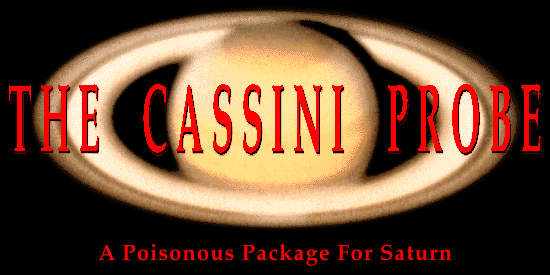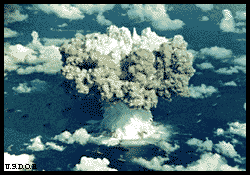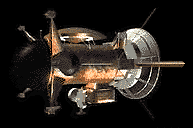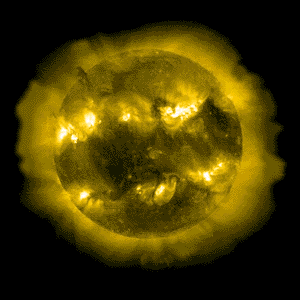 by Geraldo Fuentes
In Stanley Kubrick's movie, "2001: A Space Odyssey," the discovery of magnetic waves on the Moon reveals a rectangular monolith that heralds the acceptance of intelligent life in the Solar System. As the movie progresses, a spacecraft heads for Jupiter to explore the source of anomalous radio signals, when the onboard computer, HAL, goes psychotic and exterminates the crew. In the sequel to this movie, HAL's psychosis is traced back to bureaucratic ignorance and scientific blunder.
As is often the case, reality can be stranger than fiction. Believing that the moons of Saturn could support life, NASA launched an unmanned spacecraft to rendezvous with the ringed giant.
The Cassini Probe, named for the planet's discoverer, has just started its long sojourn in quest of extraterrestrial life, but bureaucratic ignorance has already positioned it for a catastrophic calamity. Instead of exterminating a crew of astronauts, the Cassini Probe could well snuff out life on Earth with lethal doses of poison.
The poison is plutonium, a highly radioactive material that has the power to alter genes, cause mutations and ultimately snuff out the life of anything it contacts. A small package of plutonium, about five to seven pounds in weight, has the killing strength to destroy all life on Earth. Even more frightening is the fact that plutonium remains lethal for thousands of years.
Background
It all started back in 1959. Eisenhower was president, automobiles had fins, and bountiful America was emulating the life of Ward, June and "the Beaver." The newly discovered power of atomic energy was still being tinkered with by the military, who were busy detonating nuclear bombs in America's Southwest, and vaporizing small Pacific islands to observe the effects. The newly formed Atomic Energy Commission (AEC) was anxious to exploit this new source of energy and unveiled their newest contraption: the Radioisotope Thermoelectric Generator, or RTG.
Controlling a collection of radioactive elements, such as plutonium, to create heat was attractive to the AEC. From heat, they could make electricity. And because the radioactivity of plutonium lasts for thousands of years, one could have a virtually unlimited potential of power.
Batteries lose their juice and go dead. Solar panels only recharge these batteries if there is sufficient sunlight. But, Plutonium generators, like the Eveready bunny, "keep on going." Back in 1959 the AEC clearly recognized the benefit of a perpetual generator for powering electrical equipment in everything from satellites to space probes, and the idea has been popular ever since.
Here's how the Radioisotope Thermal Generators (RTGs) work:
Safety features are incorporated into the RTG's design, and extensive testing has demonstrated that they can withstand physical conditions more severe than those expected from routine accidents occurring during launch or accidental reentry.
First, the fuel is in the heat-resistant, ceramic form of plutonium dioxide, which reduces its chance of vaporizing in fire or reentry environments. This ceramic-form fuel is also highly insoluble, has a low chemical reactivity, and primarily fractures into large, non-breathable particles and chunks. These characteristics help to mitigate the potential health effects from accidents involving the release of this fuel.
Second, the fuel is divided among 18 small, independent modular units, each with its own heat shield and impact shell. This design reduces the chances of fuel release in an accident, since all modules would not be equally impacted.
Third, multiple layers of protective materials, including iridium capsules and high-strength graphite blocks, are used to protect the fuel and prevent its accidental release. Iridium is a substance that has a very high melting point and is strong, corrosion resistant and chemically compatible with plutonium dioxide. These characteristics make iridium useful for protecting and containing each fuel pellet. Graphite is used because it is lightweight and highly heat-resistant.
(Description from the European Space Research and Technology Center)
RETURN TO SENDER
NASA admits, in its Final Environmental Impact Statement for the Cassini Mission, that if the probe
does not come in at 496 miles high-- if it dips down after hundreds of millions of miles in space
into the Earth's 75-mile high atmosphere and makes an "inadvertent reentry"-- it will break up. The Environmental Impact Statement concedes that Plutonium will be released. And, says the Statement, "approximately 5 billion, of the estimated 7 to 8 billion
world population at the time, ...could receive 99 percent, or more, of the radiation exposure."
What the public has not realized is that this danger has already existed for over 2 decades. U.S. Military and Soviet spy satellites have routinely been sent into orbit, hundreds of kilometers above our heads, with similar poisonous payloads as their source of power. The results have not been accident free.
The following is just a partial list of known accidents involving radioactive fuel, and is limited to information available through NASA, The U.S. Department of Energy, TRW and Harrow Zimmer ("Der Rote Orbit"):
Since 1964, essentially all of the SNAP-9A release has been deposited on the Earth's surface. About 25 percent was deposited in the northern latitudes, with the remaining 75 percent settling in the southern hemisphere.
Even the "successful" orbits of many of these satellites will ultimately decay, and eventually plummet to Earth. The Soviet "Kosmos" satellites currently in "stable" orbits will reenter our atmosphere in just short of 300 years. Information about all of the poisonous material in these declining orbits is still classified, but some estimates place the amount of radioactive fuel (plutonium and enriched uranium) "up there" at well over a metric ton!
Despite the global protests, the Cassini Probe was launched, and is currently on its assigned flight path. It will attempt to "bounce off" Earth's atmosphere in August of 1999. The effects of gravity on Cassini's trajectory have been carefully calculated. But critics have reminded us that the U.S. "Skylab," which was also carefully placed in a "stable" orbit, tumbled to Earth when the Sun unexpectedly flared up and sent the spacecraft in a spiraling orbit that terminated near Australia. Our ignorance of solar flares and their predictability could mean that a similar fate awaits Cassini.
All of this dangerous activity has been conducted, in fact, illegally. U.S. nuclear-powered activities in space are prohibited under the United Nations' Outer
Space Treaty of 1967. (see on UN's website:
www3.un.or.at/OOSAKiosk/treat/ost/ost.html)
Has the scientific community learned a lesson from past mishaps? Scheduled NASA launches include 12 future missions which will attempt to put a total of 132.5 kilograms of plutonium in space over the next few years. Classified military spacecraft will likely add to this figure. Perhaps our future epitaph will read "Expired, No Forwarding Address."
|
 Plutonium and other "heavy" radioactive elements have nearly a hundred electrons spinning around their central nucleus. With so many electrons, the nucleus is unable to maintain its hold on all of them, so electrons routinely escape and fly away at the speed of light. These escaping electrons are the cause of radiation and are the source of the "clicks" that we associate with Geiger counters. If you put a a large group of these atoms together, the escaping electrons from one atom can bump into other radioactive atoms, disrupting them and enabling more electrons to escape. If the number of radioactive atoms bunched together is small, you will get a by-product of heat. If the number is larger, you could have an explosion.
Plutonium and other "heavy" radioactive elements have nearly a hundred electrons spinning around their central nucleus. With so many electrons, the nucleus is unable to maintain its hold on all of them, so electrons routinely escape and fly away at the speed of light. These escaping electrons are the cause of radiation and are the source of the "clicks" that we associate with Geiger counters. If you put a a large group of these atoms together, the escaping electrons from one atom can bump into other radioactive atoms, disrupting them and enabling more electrons to escape. If the number of radioactive atoms bunched together is small, you will get a by-product of heat. If the number is larger, you could have an explosion. The public was largely ignorant that such potentially dangerous fuel was being sent into space until the launch of the Cassini Probe in October of 1997. Public outcries to stop the mission were fueled by the surprising revelation that the probe, designed to land and seek life on a distant moon of Saturn, was sent on a trajectory that would cause it to circle back to Earth at about 42,300 miles per hour, bounce off our atmosphere just 496 miles high, and then slingshot to its rendezvous with Saturn. The possibility of an accident was estimated by NASA to be one chance in a million. But such an accident could sprinkle Earth with over ten times the poison needed to destroy all life, and was (and still is) considered by many scientists too much of a risk. The safety features incorporated into the Cassini's RTG will not withstand the potential reentry speed.
The public was largely ignorant that such potentially dangerous fuel was being sent into space until the launch of the Cassini Probe in October of 1997. Public outcries to stop the mission were fueled by the surprising revelation that the probe, designed to land and seek life on a distant moon of Saturn, was sent on a trajectory that would cause it to circle back to Earth at about 42,300 miles per hour, bounce off our atmosphere just 496 miles high, and then slingshot to its rendezvous with Saturn. The possibility of an accident was estimated by NASA to be one chance in a million. But such an accident could sprinkle Earth with over ten times the poison needed to destroy all life, and was (and still is) considered by many scientists too much of a risk. The safety features incorporated into the Cassini's RTG will not withstand the potential reentry speed. Dr. Rollin Gillespie has recently shown that the axial rotation and orbital position of the planets is intimately linked to the Sun's eruption of solar flares at various solar latitudes. This relationship is just now being understood. Ironically, astronomers are predicting that a unique planetary alignment called "The Grand Cross," during which the major planets will be aligned at right angles to the Sun, will coincide with the return of the Cassini (August 1999) and its 70 plus pounds of plutonium. A solar flare-up during this critical period could be the recipe for disaster. (See
Dr. Rollin Gillespie has recently shown that the axial rotation and orbital position of the planets is intimately linked to the Sun's eruption of solar flares at various solar latitudes. This relationship is just now being understood. Ironically, astronomers are predicting that a unique planetary alignment called "The Grand Cross," during which the major planets will be aligned at right angles to the Sun, will coincide with the return of the Cassini (August 1999) and its 70 plus pounds of plutonium. A solar flare-up during this critical period could be the recipe for disaster. (See